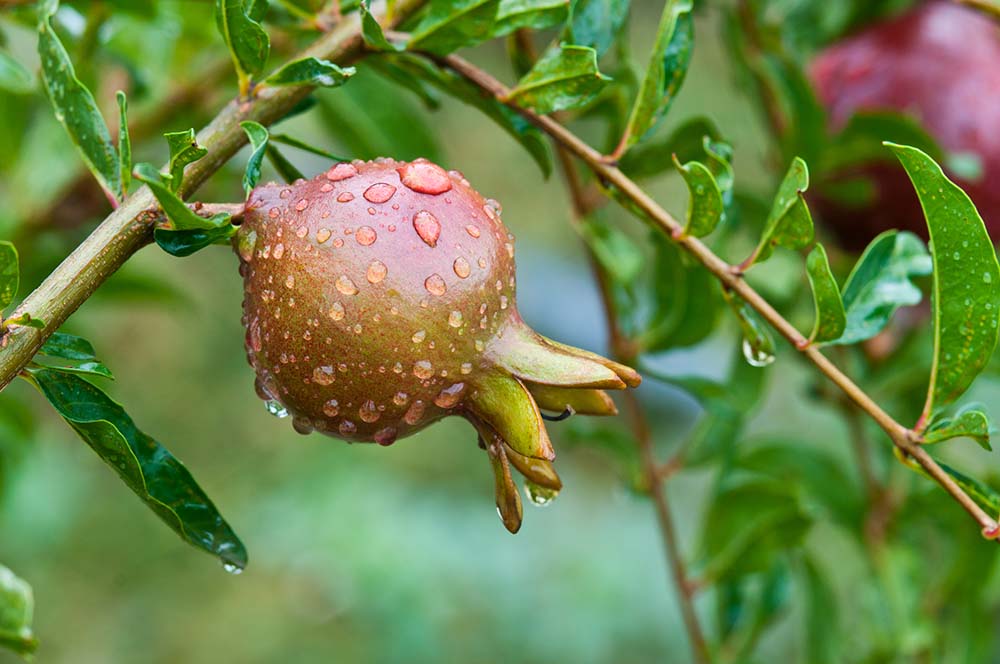
We may receive commissions from purchases made through links in this post, at no additional cost to you.
Everything you read about growing pomegranates sounds too good to be true…Fast growing! Productive! Disease and pest resistant! Adaptable to different soils! Drought tolerant! But (at least for me) the minute I actually planted a pomegranate tree, questions began forming in my mind – particularly about watering.
How much water is too much? And, ok, it’s a drought-tolerant plant, but does that mean I don’t need to water it at all? What about right after it’s planted? How do you know when to irrigate (or not)? And how do I fix watering issues when I inevitably get it wrong?
After a lot of research, a little struggle, some trial and error, and eventual success, I have arrived at practical answers to these questions.
Pomegranate trees are drought-tolerant, but they need regular watering in order to support developing fruit. Young trees need more frequent watering than mature, established trees. Increase watering frequency in hot weather, and aim to keep the soil evenly moist but not saturated.
In this article, I hope to save you some of the time and trouble it took for me to figure out my pomegranate tree’s watering needs. We’ll look at how much to water the tree, when to do it, and how to troubleshoot watering issues.
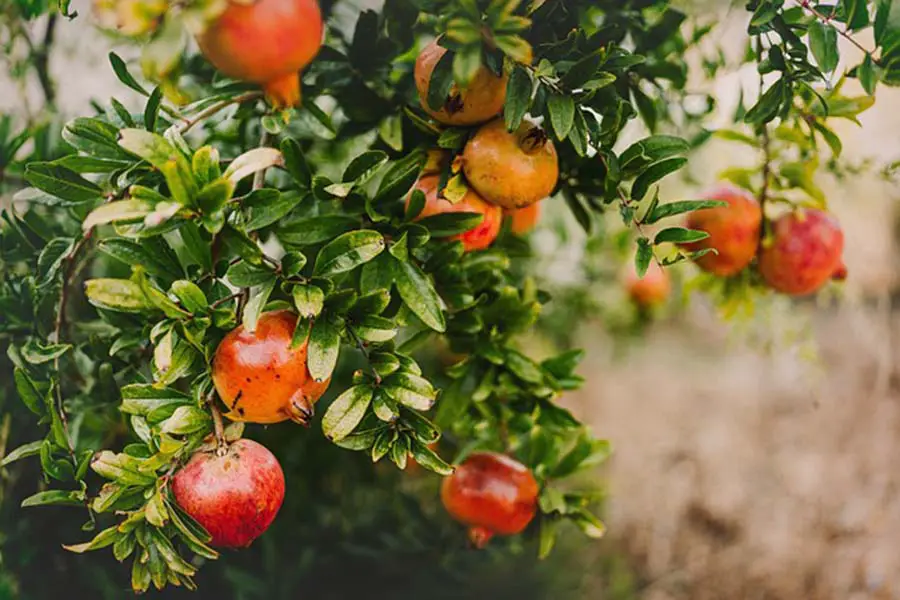
How much water does a pomegranate tree need?
In general, a pomegranate tree needs about 45-65 inches of water (including rainfall) per year. This is comparable to a citrus tree’s watering needs – which makes sense since they are both tropical/subtropical plants that prefer warm climates.
For reference, an inch of water equates to 0.62 gallons per square foot of space. But really, unless you are toting around a gallon jug and measuring tape, it will take some figuring to convert that to something helpful.
If your pomegranate tree’s dripline is 6 feet in diameter, then it’s about 28 square feet total. Multiply that by 0.62, and you get 17.36 gallons – the number of gallons needed to give the tree 1 inch of water.
Check Your Average Rainfall
To figure out how much to water your pomegranate tree, start by determining your area’s average rainfall per year. A quick Google search of “average rainfall [your county/zip code/city]” will probably get the results you need. Or visit this site to see an average precipitation map for the U.S. (pictured below).
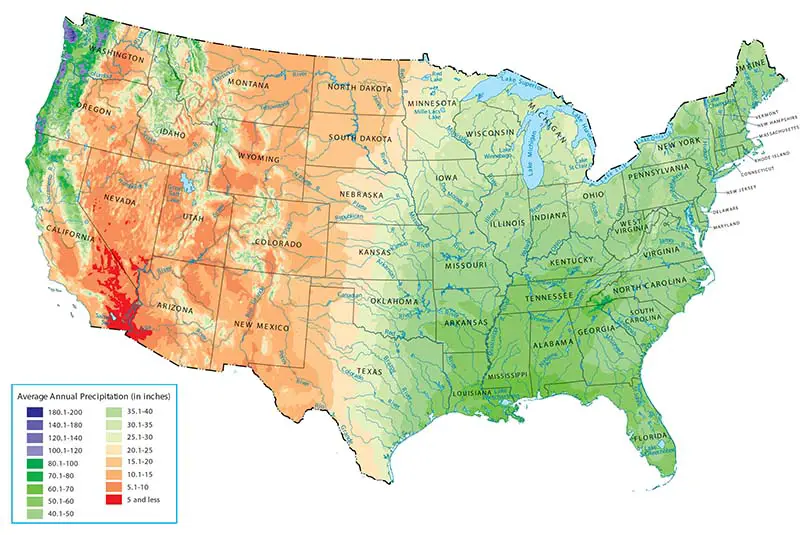
Knowing the average rainfall will help you estimate how much additional water your pomegranate might need each year. Of course, there are rainy seasons and dry spells to contend with, so it really is just an estimate. There are other important factors to consider:
Soil Type
Pomegranate trees can tolerate a wide range of soils, from heavy, alkaline clay to lean, acidic sand. But the type of soil will greatly affect how much water the tree needs. The most important thing is that, whatever the soil type, it must be very well-drained.
Soil with a high concentration of clay will retain much more moisture, so you may not need to irrigate as often. Clay contains very small particles that clump together and prevent water from draining as quickly.
Light, sandy soil will allow water to drain very fast, so you may need to water more frequently, especially during hot, dry weather. My soil is a very sandy loam, which my pomegranate tree loves – as long as I water it regularly.
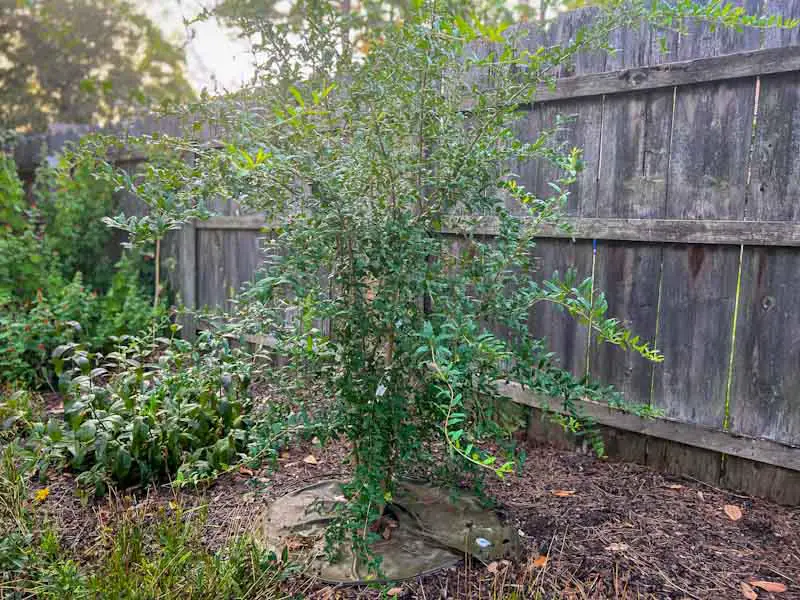
Fertile, loamy soil is ideal and will be best at naturally balancing drainage and water retention. If you are blessed with this type of soil, you may only need to water during extended hot, dry spells.
Temperature
Speaking of heat, the temperature and weather will affect how much water to give your tree. Pomegranate trees love hot, dry air, but the roots must be kept evenly moist for the best growth and fruiting.
Basically, the hotter the weather, the more water is needed. Hot air causes more moisture to evaporate from the leaves, and therefore more moisture is needed to replace the water loss. Excessive wind can also increase evaporation.
Hopefully rainfall will take care of some of the tree’s water needs, but if the rain is light, or if there is more than a week between showers, then give your pomegranate tree a deep drink. As the weather cools down in fall, the tree will need less additional water.
A thick layer of breathable, organic mulch (such as pine straw, pine bark, or compost) will help prevent surface evaporation. Spread the mulch about 6 inches away from the trunk to just beyond the tree’s dripline (the reach of the canopy).
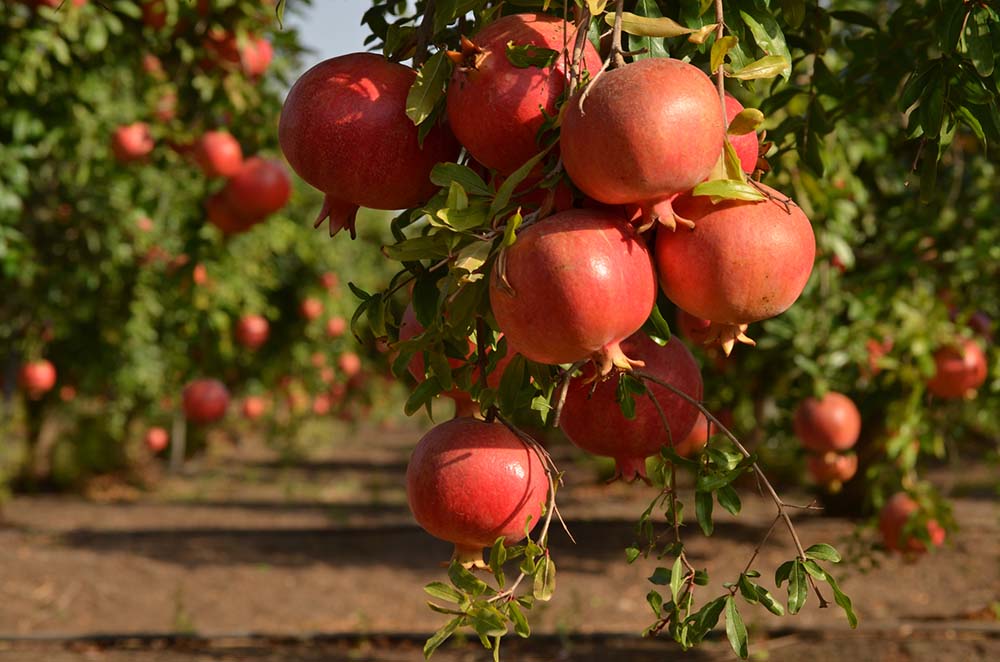
Time of Year
Pomegranate trees need more water during the active growing and fruiting season than they do in dormancy. Plan to adjust your watering habits depending on the time of year.
In spring and summer, the goal is to keep the soil as consistently moist as possible. Regular watering is key, as this is when the tree is blossoming and developing its fruit. If watering is inconsistent during the fruiting season, it may lead to fruit cracking or dropping off the tree.
In my climate, I usually don’t need to supplement with irrigation during the rainy spring, but I do need to water my pomegranate tree once or twice a week during the intense summer heat.
In fall, as the temperatures begin to cool (or, in my case, get slightly less scorching), expect the watering needs to slow down. The goal remains the same – consistently moist, but not saturated, soil – but it won’t take as much additional water. Most pomegranates aren’t ready to harvest until early fall, so watering habits still need to support the fruit crop.
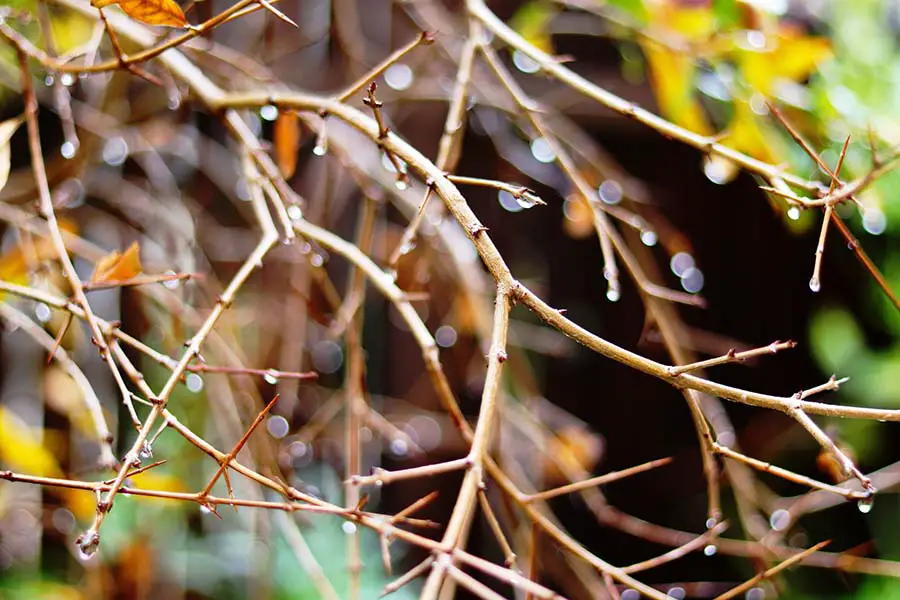
Once a pomegranate tree goes dormant in winter (when it drops all its leaves), it may not need much water at all. If a deep freeze is in the forecast and the soil is very dry, then go ahead and water the root area thoroughly. The ground will freeze at 32°F, which is well above any pomegranate’s tree cold tolerance, and ice will insulate the roots. If the dry ground freezes, it will be closer to the colder air temperature and could damage the roots.
Tree Age
Pomegranate trees, like just about every plant, need much more water for the first year after planting (more on this below). A new tree needs plenty of water to support its growing root system.
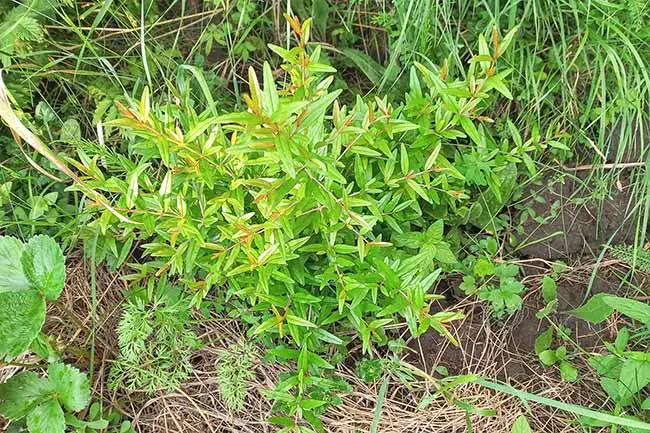
Once the tree is a bit more mature (after 3-5 years, say), it will probably need much less additional water throughout the year. The bigger the tree, the broader and more established the root system, and the better the roots are at seeking the water they need.
When should you water a pomegranate tree?
Watering at Planting
When you plant a pomegranate tree, give the soil a very thorough soak that reaches the soil around the entire root ball. Even if you watered the tree while it was still in its nursery pot (or if you soaked the roots of a bare-root tree), the surrounding soil also needs to be moistened.
After you’ve backfilled the planting hole about halfway, tamp down the soil and water the hole well. Continue backfilling, tamping, and water again once finished.
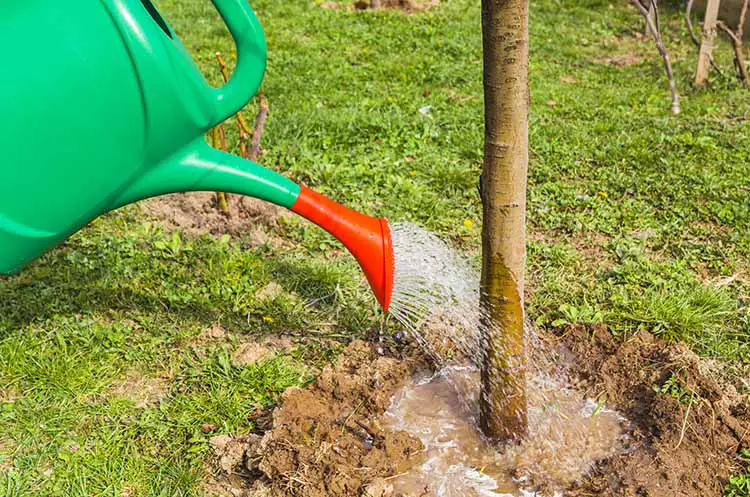
It’s a good idea to construct a berm around your newly planted tree. To make one, pile up 3-4 inches of soil in a ring around the trunk, about 2-3 feet in diameter. The berm will serve as a water basin, catching rainfall (and hand-watering) and allowing it to soak into the roots. After several months, the soil ring will settle into the soil, but by that time your tree’s roots will be established.
Water the tree about twice a week for the first month after planting. After that, water weekly (if there was no rain). Increase the frequency of watering as necessary (every few days) during hot, dry weather.
I recommend using these tree watering bags for young trees. They are inexpensive, reusable, and simple to use. Just fill each ring from the hose, then the water will slowly drip from emitters in the bottom, allowing the roots to absorb the water over about 8 hours.
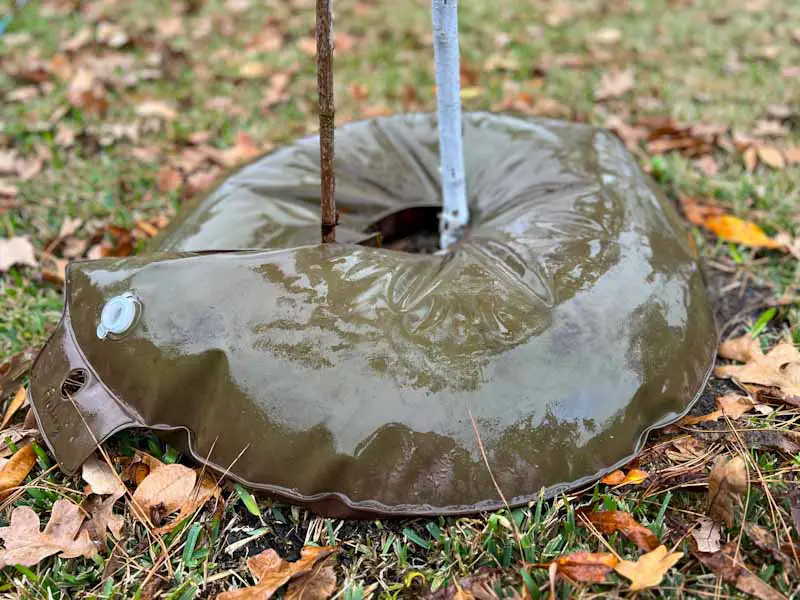
These bags have saved my newly planted fruit trees (and my sanity) during scorching summer dry spells. It’s also easy to have someone come over and fill them once or twice when we are traveling.
Watering an Established Tree
Once the tree grows for a season or two, you won’t need supplemental water as often. If there is more than a week of dry weather, especially if it is very hot, then water the tree deeply.
If you use drip irrigation, use 1-gallon-per-hour drip emitters. As a rule of thumb, a 1-year-old tree needs one or two emitters, then add an emitter each year for the next few years as the tree grows.
You can also hand water with a garden hose. Turn on the hose to a trickle, then position it near the dripline where the water-absorbing feeder roots are located. After 15 minutes or so, move the hose to another spot around the tree, and continue until the ground around the tree is moist. It may take 45 minutes to an hour to water deeply.
Watering During Fruiting
As I mentioned above, pomegranate trees need more frequent watering during the fruiting season. Pomegranates take 6 to 7 months to mature on the tree, from fertilization (pollination) to harvest. During that time, the tree needs consistent moisture to support fruit development.
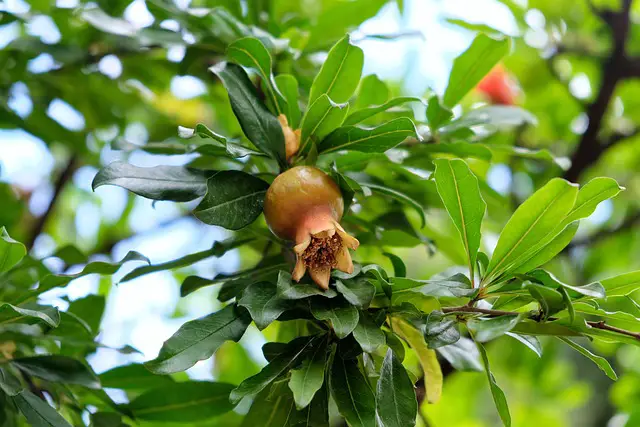
Pomegranate trees are drought tolerant, yes, meaning the tree will survive periods of little to no water. But, regular watering is essential if you want your tree to grow a good crop of pomegranates. Too little water, or irregular periods of drought followed by a heavy watering (like a storm) will cause the fruit to crack, split wide open, or fall off the tree.
Depending on the weather, water every 1-2 weeks during the fruiting season. Don’t water if you notice that the soil is already very moist or saturated. Wait until the top 2-3 inches of soil are dry.
Watering During Hot, Dry Spells
When the temperatures are high and precipitation is low (or nonexistent), water your pomegranate tree deeply every 7 to 10 days (more often if the tree is younger, or if the temperatures are extremely hot). It’s better to water deeply and let the soil dry out just a little between waterings, rather than shallow, frequent sprinkles.
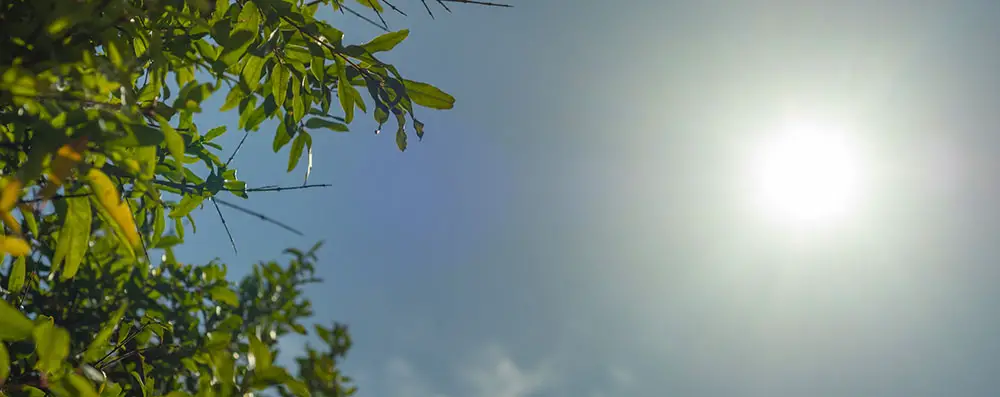
Watering During Dormancy
Once a pomegranate tree is dormant, it needs very little water. Dormancy is a kind of plant hibernation – the tree drops its leaves and conserves energy to protect itself from the cold, then it’s ready to “spring” back into life come the next growing season. Since a dormant tree is in a state of suspended living, less water is best.
Most locations probably have enough winter precipitation that no additional watering is needed. If your winter is very dry or unusually warm, water at most once a month.
Watering a Potted Pomegranate Tree
Pomegranate trees grown in pots have the same watering needs as those planted in the ground. Water more frequently and regularly during the growing season, and less (if at all) while the plant is dormant. Pay attention to the weather, and increase watering during hot, dry spells.
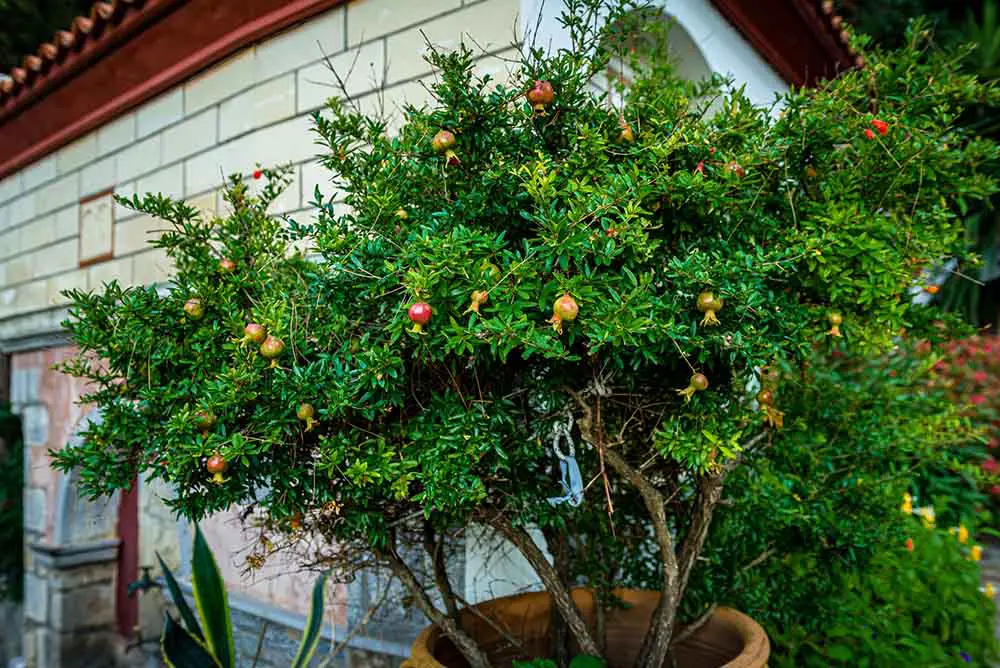
The difference is in the frequency of watering. Potted trees have much more limited root systems, and limited soil in which to seek out moisture. During the hottest part of the year, you will probably need to water a potted pomegranate at least once a day.
Is my pomegranate tree overwatered or under-watered?
Signs of Overwatering
- Yellowing leaves. Pomegranate trees’ leaves naturally turn yellow-gold in the fall, but pale or yellow leaves during the growing season may be a sign of overwatering. The leaves will then turn brown and eventually fall off the tree.
- Fruit splitting. Excessive water as the fruit is ripening could cause the thick skin of a pomegranate to crack or, in some cases, split wide open. This occurs especially when a tree is overwatered after a dry spell. The extra moisture causes the inside to swell quickly, cracking the fruit.
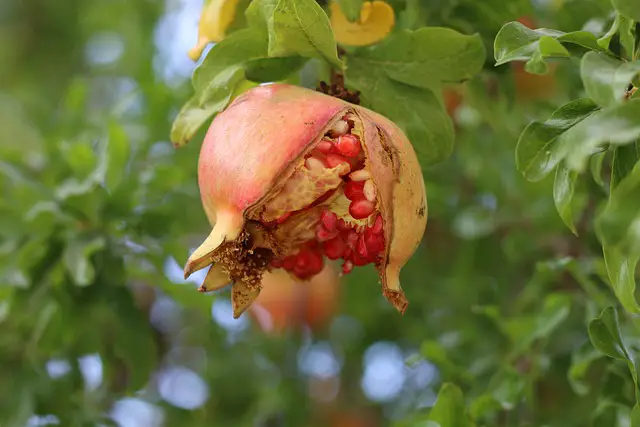
- Root rot. Consistent overwatering, or watering too much in heavy, water-retentive soil, suffocates the roots and can lead to root rot or other diseases. Root rot is typically fatal for pomegranate trees.
How to Fix It:
As soon as you notice signs of overwatering, check the soil. Is it saturated? Adjust your watering regimen and water less frequently. Consider setting up drip irrigation on a timer so you can easily control how often the tree is watered.
If the soil is saturated, use a wooden rod or broom handle to poke a few deep holes in the soil surrounding the tree. This can increase air circulation around the roots and help the soil to dry out a little more quickly.
Signs of Under-watering
- Tips of leaves drooping. The first sign of underwatering is usually drooping leaves, or leaves with curled tips and/or brown edges.
- Brown, dry, or dead leaves. The drooping leaves will eventually turn brown and dead-looking.
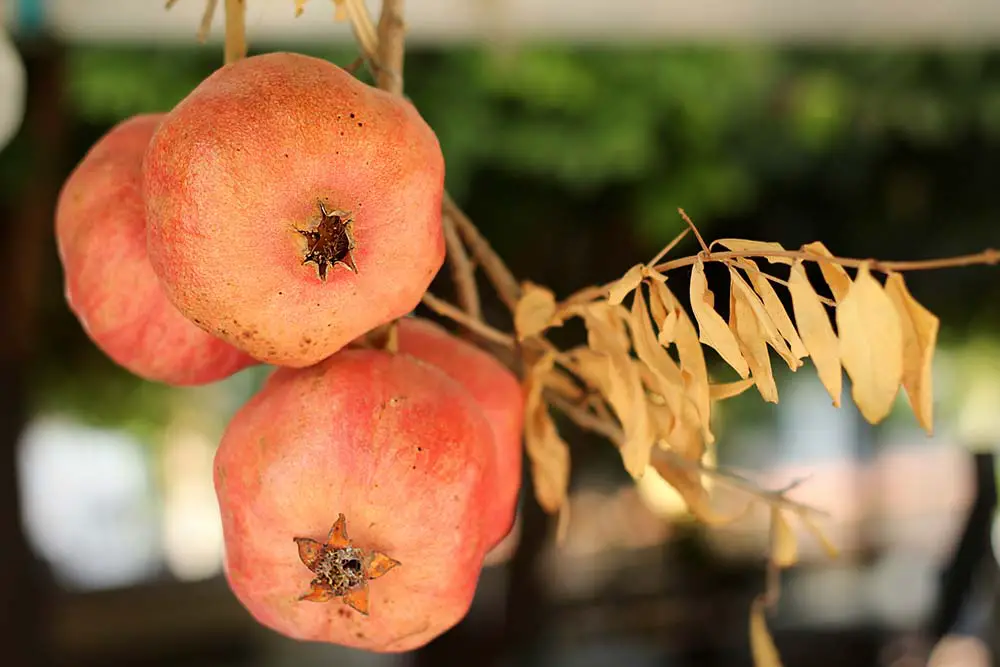
- Leaf drop. When a tree is drought-stressed, it may drop its leaves in an effort to conserve energy. In a way, this is a good sign since it means the tree is trying to stay alive. If you notice lots of dead leaves clinging to a branch, however, that probably means that the branch is dead and needs to be removed.
- Stunted growth. Growth will slow down or even stop if a pomegranate tree goes too long without water. The tree may look sparse, sickly, and stressed.
- Fruit drop. Yes, the fruit could drop due to underwatering as well as overwatering. In this case, the tree will probably show some of the other signs above first before it needs to drop its fruit.
How to Fix It:
Increase your watering frequency and/or the depth of watering. It’s generally better to water deeply a little less often, than frequent shallow watering. If your pomegranate tree shows signs of needing more water, set a reminder on your phone, or set up drip irrigation on an automatic timer.
The good news is, a pomegranate tree will bounce back quickly if you catch the under- or overwatering symptoms early. Adjust your watering habits, and keep a close eye on the tree. You may lose some fruit this season, but the tree will likely be just fine in the long run.

